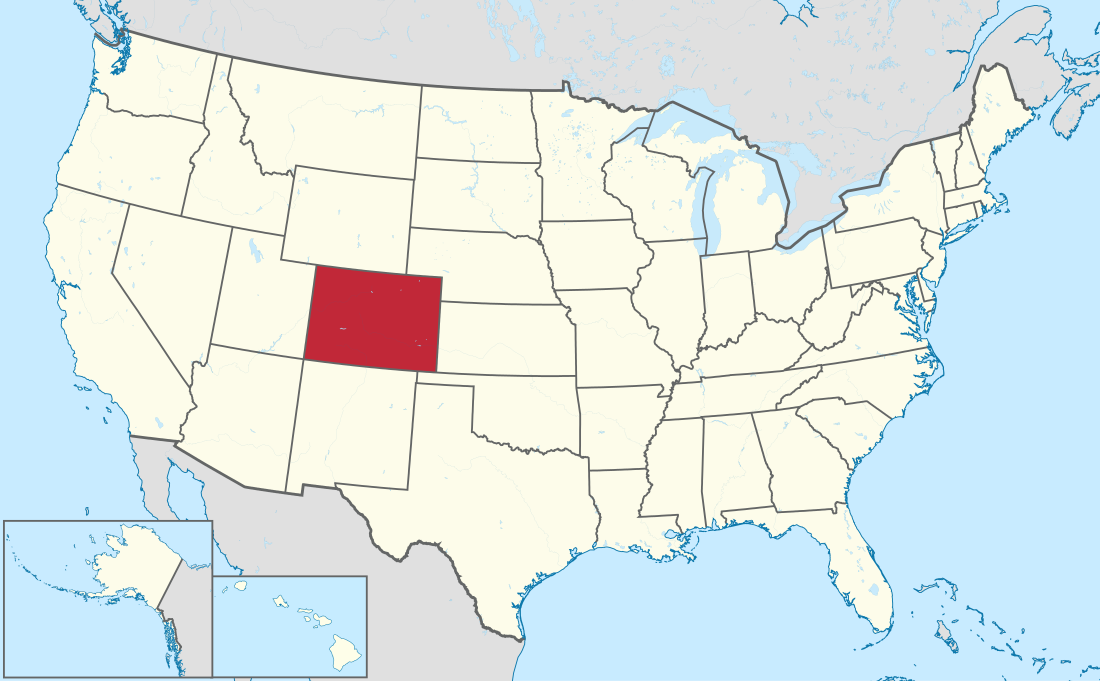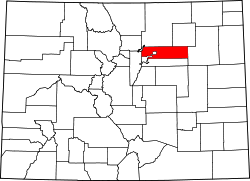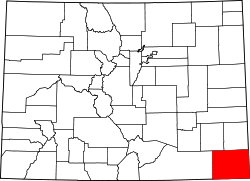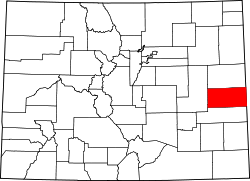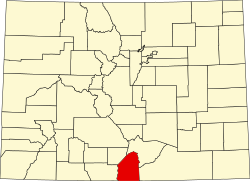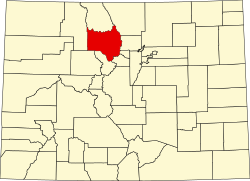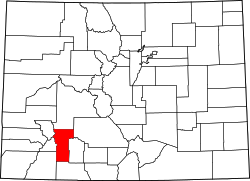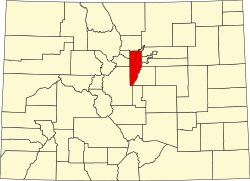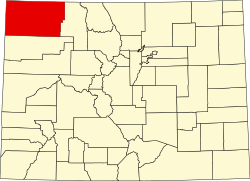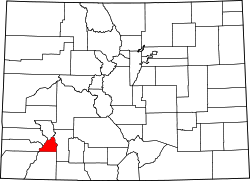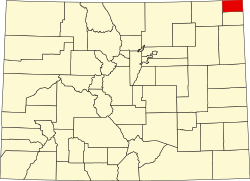Top Qs
Timeline
Chat
Perspective
List of counties in Colorado
From Wikipedia, the free encyclopedia
Remove ads
The U.S. State of Colorado is divided into 64 counties.[1] Two of these, the City and County of Denver, which serves as the state capital, and the City and County of Broomfield, have consolidated city and county governments. In addition to Denver and Broomfield, Pitkin County and Weld County operate as home rule counties with their own county charters.[2] The other 60 counties operate under state regulations per Dillon's Rule. Counties are important units of government in Colorado since there are no civil townships or other minor civil divisions.


The 64 counties of the U.S. State of Colorado.
The United States Census Bureau estimates that El Paso County remains the most populous county in Colorado with a population estimate of 752,772, as of July 1, 2024, while Hinsdale County with a population of 747 is now the least populous.[a] Five of the 64 Colorado counties now have more than 500,000 residents, while 12 counties have fewer than 5,000 residents.[a]
Las Animas County, 4,776 square miles (12,369 km2) in area, is the most extensive county, while the City and County of Broomfield, 34 square miles (87 km2) in area, is the least extensive. The City and County of Denver was the most densely populated Colorado county, with a 2024 population density of 4,918 residents per square mile of land area (1,899/km2), while Hinsdale County was the least densely populated county, with a 2024 population density of 0.67 resident per square mile of land area (0.26/km2).
Mount Elbert, the highest summit of Colorado and the entire Rocky Mountains at an elevation of 14,440 feet (4,401.2 m), is located in Lake County. The lowest point in Colorado is where the Arikaree River flows out of Yuma County and into Kansas, at 3,317 feet (1,011 m) elevation.[b] This point, which is the highest low point of any state, is higher than the highest points of 18 states and the District of Columbia.[4]
Remove ads
History
Summarize
Perspective
On November 1, 1861, the new Territory of Colorado created 17 original counties: Arapahoe, Boulder, Clear Creek, Costilla, Douglas, El Paso, Fremont, Gilpin, Guadalupe, Huerfano, Jefferson, Lake, Larimer, Park, Pueblo, Summit, and Weld; plus the Cheyenne Reserve.[5][6] Six days later, the name of Guadelupe County was changed to Conejos County.
On February 9, 1866, the first new county, Las Animas, was created, followed by Saguache in December of that year. Bent County was created in February 1870, followed by Greenwood the following month. On February 2, 1874, Grand County and Elbert County were formed, and on February 10, La Plata, Hinsdale, and Rio Grande counties were created. Greenwood was absorbed into Bent on February 5. The last county to be created under the Colorado Territory name was San Juan County, created three months before statehood.
By the time Colorado became a state on August 1, 1876, it had only 26 counties. In January 1877, Routt and Ouray were formed, followed by Gunnison and Custer counties in March. In February 1879, Chaffee County was created. From February 8–10, 1879, Lake county was renamed Carbonate County. In 1881, Dolores County and Pitkin County were created. In 1883, Montrose, Mesa, Garfield, Eagle, Delta, and San Miguel counties were formed, leaving the total number of counties at 39. The number rose to 40 in 1885 with the creation of Archuleta County on April 14. Washington County and Logan County were both created in 1887. Between February 19 and April 16 in 1889, Morgan, Yuma, Cheyenne, Otero, Rio Blanco, Phillips, Sedgwick, Kiowa, Kit Carson, Lincoln, Prowers, Baca, and Montezuma counties were formed, bringing the total to 55. By 1900, Mineral County and Teller County had been added. On November 15, 1902, Arapahoe County was split into Adams and South Arapahoe Counties, and Denver was reconstituted as a consolidated city-county from portions of both newly formed counties on December 1, 1902.[7] By 1912, Jackson County, Moffat County, and Crowley County had been created. Alamosa was created in 1913. In 2001, Broomfield was reconstituted as a consolidated city-county from parts of Adams, Boulder, Jefferson and Weld counties, bringing the total to 64 counties.
Remove ads
Colorado counties
Summarize
Perspective
Select the OpenStreetMap link at the right to view the location of these 64 counties.
- For Colorado counties by statistical area, see the List of statistical areas in Colorado.
- For Colorado county seats, see the List of county seats in Colorado.
- For Colorado county courthouses, see the List of Colorado county courthouses.
- For Colorado county per capita income, see the List of Colorado counties by per capita income
- For Colorado county socioeconomics, see the List of Colorado counties by socioeconomic factors.
- For Colorado county highest elevation points, see the List of Colorado county high points.
- For Colorado municipalities by county, see the List of Colorado municipalities by county.
- For Colorado populated places by county, see the List of Colorado populated places by county.
- For Colorado county maps, see the State of Colorado Map Viewer.
Remove ads
County population
Remove ads
Former counties
Summarize
Perspective
The following sortable table lists all the historic counties of the Territory of New Mexico, the Territory of Utah, the Territory of Kansas, and the extralegal Territory of Jefferson[16] that previously existed within the boundaries of the present State of Colorado, as well as the three defunct counties of the Territory of Colorado and the three defunct counties of the State of Colorado.[f]
Remove ads
County high points
Of the 64 Colorado counties, 20 counties extend above 14,000 feet (4,267 m) elevation, 32 counties extend above 13,000 feet (3,962 m), 42 counties extend above 10,000 feet (3,048 m), and all 64 Colorado counties extend above 4,116 feet (1,255 m).
County mean elevation
Summarize
Perspective
Of Colorado's 64 counties, 4 counties have a mean elevation[g] above 11,000 feet (3,353 m) elevation, 22 counties have a mean elevation above 10,000 feet (3,048 m), 32 counties have a mean elevation above 9,000 feet (2,743 m), and all 64 counties have a mean elevation above 3,880 feet (1,183 m).
The following 13 Colorado counties have highest mean elevation of any county in the United States, exceeding even the Denali Borough of Alaska.
Remove ads
County firsts
- 1. Costilla County was the first area within the present State of Colorado to be settled by Europeans in 1851.
- 2. Taos County, created by the Territory of New Mexico in 1852, was the first organized county to extend into the area of the present State of Colorado.
- 3. Arapahoe County, created by the Territory of Kansas in 1855, was the first county created exclusively within the area of the present State of Colorado.
- 4. On November 28, 1859, the extralegal Territory of Jefferson created 12 counties:[16]
- 5. On November 1, 1861, the Territory of Colorado created the 17 original Colorado counties:
- 6. Of the 17 original Colorado counties created in 1861, only Gilpin County and Clear Creek County have retained their original boundaries with only minor survey changes.
- 7. Guadaloupe County was the first Colorado county to be renamed after only six days in 1861.
- 8. Las Animas County was the first new Colorado county to be created (in 1866) after the original 17 counties.
- 9. Greenwood County was the longest lived former Colorado county, existing four years from 1870 to 1874.
- 10. In 1876, San Juan County became the last county created by the Territory of Colorado, bringing the total number of territorial counties to 26.
- 11. In 1877, Ouray County became the first county created by the new State of Colorado.
- 12. Carbonate County was the shortest lived former Colorado county, existing only two days in 1879 before being dissolved.
- 13. The City and County of Broomfield became the newest Colorado county in 2001, bring the total number of counties to 64.
Remove ads
County distinctions
- 1. El Paso County (88) and the City and County of Denver (93) and are among the 100 most populous counties of the United States.
- 2. San Juan County (16), Hinsdale County (25), Mineral County (32), Jackson County (55), Kiowa County (59), and Cheyenne County (80) are among the 100 least populous counties of the United States.
- 3. Jefferson County borders ten adjacent counties, the most of any Colorado county.[l]
- 4. Delta County and the City and County of Denver each border only three adjacent counties, the fewest of Colorado counties.[m]
- 5. Weld County has the most incorporated municipalities of any Colorado county with 31.
- 6. The following nine Colorado counties have no incorporated municipalities other than their county seat:
- 7. Of all 64 Colorado counties, only Conejos County has a county seat that is not an incorporated municipality.
- 8. The City and County of Denver and the City and County of Broomfield are the only two Colorado counties with enclaves. Arapahoe County, Boulder County, and Jefferson County are the only three Colorado counties with exclaves.
- 9. Pitkin and Weld are the only home rule counties.
Remove ads
Gallery
- The ten most populous Colorado counties
- 2. The Colorado State Capitol in the City and County of Denver
- 3. A bank building in Arapahoe County, Colorado
- 8. The Greeley Stampede Parade in Weld County, Colorado
See also
- Bibliography of Colorado
- Geography of Colorado
- History of Colorado
- Index of Colorado-related articles
- List of Colorado-related lists
- List of Colorado counties by per capita income
- List of Colorado counties by population
- List of Colorado counties by socioeconomic factors
- List of Colorado counties by statistical area
- List of Colorado county high points
- List of Colorado municipalities by county
- List of Colorado populated places by county
- List of county courthouses in Colorado
- List of county seats in Colorado
- Outline of Colorado
Remove ads
Notes
- United States Census Bureau estimates of county population as of July 1, 2024,[3]
- Elevations are adjusted to the North American Vertical Datum of 1988 (NAVD 88).
- The ANSI INCITS 31:2009 county code is the five-digit code which uniquely identifies counties and county equivalents in the United States. The three-digit number is unique to each individual county within a state, but to be unique within the entire United States, it must be prefixed by the two-digit ANSI INCITS 31:2009 state code. This means that, for example, while Adams County, Colorado is 001, Belknap County, New Hampshire and Alachua County, Florida are also 001. To uniquely identify Adams County, Colorado, one must use the state code of 08 plus the county code of 001; therefore, the unique nationwide identifier for Adams County, Colorado is 08001. The links in the column INCITS are to the Census Bureau Info page for that county.
- The name "Saguache" is pronounced /səˈwætʃ/. This name comes from the Ute language noun "sawup" /səˈwʌp/ meaning "sand dunes". The Spanish language version of this name is usually spelled "Saguache", while the English language version is usually spelled "Sawatch".
- The centroid geographic coordinates of the county as determined by the United States Census Bureau.[15]
- No organized counties of the District of Louisiana, the Territory of Missouri, the extralegal State of Deseret, or the Territory of Nebraska existed within the present boundaries of the State of Colorado.
- The "mean of extremes" elevation is the arithmetic mean of the highest and lowest elevations.
- Rank among United States counties and county-equivalents by mean elevation.
- The elevation range is the arithmetic difference between the highest and lowest elevations.
- The point where the Arkansas River flows out of Lake County and into Chaffee County, Colorado, is the highest county low point in the United States at 8,965 feet (2,733 m) elevation.
- San Miguel was the original seat of Costilla County. In 1863, the Costilla County seat was moved 17 miles (27 km) north to San Luis. It was not until 1869, that surveys revealed that San Miguel, now renamed Costilla, was actually located in the New Mexico Territory.
- Delta County, Colorado borders Gunnison County, Montrose County, and Mesa County, Colorado. The City and County of Denver, Colorado borders Adams County, Arapahoe County, and Jefferson County, Colorado.
Remove ads
References
Further reading
External links
Wikiwand - on
Seamless Wikipedia browsing. On steroids.
Remove ads
